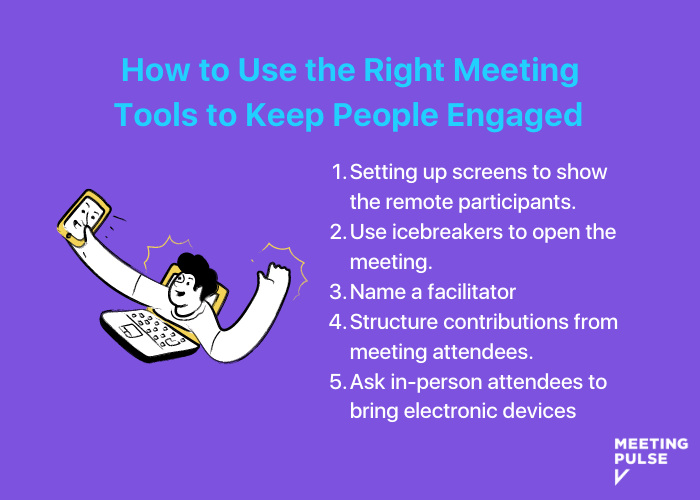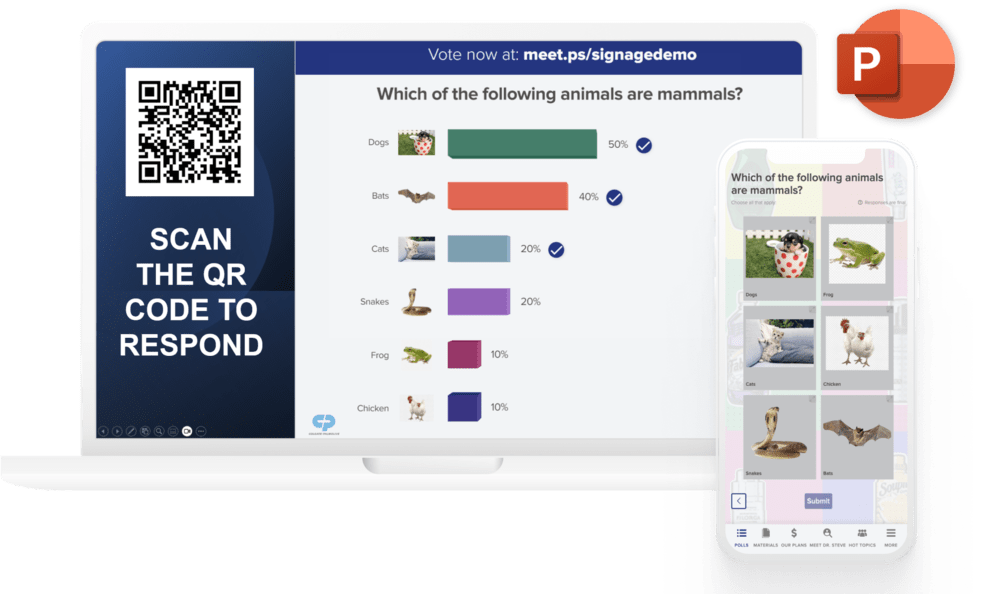The way we work has arguably changed more in the past couple of years than ever. With the uptick in hybrid workplaces, remote employees are more frequently visiting the conference room via hybrid meetings. About 90% of organizations will offer some form of remote and on-site work as a result of workplace impacts of COVID, according to a McKinsey survey.
Gone are the days when all employees only gathered face-to-face for meetings. The future is hybrid. While holding any meeting comes with its challenges, hosting a hybrid meeting presents new hurdles. But when done right, a great hybrid meeting can make all meeting attendees feel connected.
A hybrid meeting is one that employs video conferencing to bring remote team members and in-person attendees together. Remote attendees join the meeting room through a virtual platform while in-person attendees gather as usual in a meeting room.
Virtual meeting technology does have one serious perk over a physical meeting. It can accommodate remote attendees, distributed team, or employees who would otherwise not be able to attend an in-person meeting. By adding a virtual option for remote workers, you’re allowing everyone to have a presence in the room.
That being said, a not-so-great virtual environment can turn off remote participants and make them feel excluded. This is almost tragic, since the whole point is to bring them to be part of the meeting. In this article, we will offer hybrid meeting best practices for making everyone feel at ease and part of the decision making.
Hybrid meetings require more planning
Given the use of technology, it takes a bit more time and thought to plan good hybrid meetings. Give primary consideration to all things remote, because your biggest danger as a meeting host is losing your virtual attendees. If you’re unfamiliar with the technology or not prepared to share information with your remote colleagues with ease, you stand the chance of making them feel less involved and, ultimately, less appreciated.
It’s important to give your virtual attendees the chance to speak and engage as much as the employees with a physical presence in your meeting spaces. It’s easy to let in-person attendees take up more of the floor, so to speak, but that’s another sure-fire way to isolate your remote team members. If you have taken the time to build a team with a wide diversity of thought, you want to make sure you give them every opportunity to contribute through virtual meetings, face-to-face meetings, hybrid meetings and any other kind of gathering.
Before you plan your first hybrid meeting, consider the software you’re using. Does it allow both in-person and remote connection? Is it easy to share presentations, documents, or other information and make it accessible to all team members? If you answered no to any of those questions, it’s time to find a new platform.
Once you find a software system that works for hybrid meetings, consider appointing a meeting planner. That person can handle the details to keep any complications to a minimum, such as:
- Scheduling. Are all of your employees located in the same time zone? If so, great. If not, it’s going to take a little more consideration to find a time that works well for everyone. There is almost nothing worse than getting a meeting request that’s outside of your working hours.
- Test the technology. This cannot be stressed enough. Do a couple of run throughs to make sure you know how to use the meeting platform. Test share some documents. Upload a presentation. Figure out how to use any chat functions. If you take the time to do this, the meeting will go much smoother.
- Consider camera positions. For those in the physical space, think about where the camera will be placed. Ultimately, it should be somewhere that allows remote attendees to see everything happening in the room.
- Check your audio. Before the meeting starts, log on early and make sure the mic is working appropriately. Ask another team member to log on remotely to make sure you can be heard clearly. Even better, consider adding a professional microphone to your meeting room. It’ll be too late if you wait until the meeting begins and find out half your attendees can’t hear a word you’re saying.
- Set some ground rules. Do you want your remote attendees to have their cameras turned on? Would you like to limit distractions by asking both in-person and remote attendees to refrain from snacking? How will you control the conversation and taking turns talking? Think about this ahead of time and share your meeting rules with everyone before the meeting begins. You can remind them of the rules, briefly, once the meeting begins if you’d like.
Use the right tools to keep people engaged
After you’ve carefully planned and tested all of your equipment and software, it’s time to bring your teammates together to share and generate ideas. There are a great many tools available to help with that, including:
- Setting up screens to show the remote participants. It might not make much sense at first, but when you have a dedicated visual of the people who are joining the meeting virtually, it’ll be much harder to forget they’re there. The Harvard Business Review even recommends employing two large screens to show remote participants in “life-size” panes.
- Use icebreakers to open the meeting. It can take a minute or two to get a meeting off the ground. That’s even more true with a hybrid meeting. An icebreaker can help warm up your attendees, help them relax and encourage them to have a little fun. MeetingPulse’s array of services enables you to ask open-ended questions and find other icebreakers for your group.
- Name a facilitator. In the same way you might use a programmer to help plan hybrid meetings, a facilitator can be especially helpful by keeping your remote attendees engaged. A facilitator can also monitor for things like employees unmuting their microphones in preparation to speak. Ultimately, they can act as an advocate for any employee that’s not in the room.
- Structure contributions from meeting attendees. Provide your teammates with a variety of ways to communicate. Some of those tools will even help you receive input that is more inclusive. Polls and surveys are excellent ways to do just that. MeetingPulse gives the option of accepting anonymous input, which makes some people more comfortable expressing themselves. Encourage people to throw ideas or shorter comments in the chat forum, and be sure to call on employees directly if you suspect they have something to contribute.
- Ask in-person attendees to bring electronic devices. Even though they’re in the physical meeting room, asking in-person attendees to bring along their laptops or smartphones will allow them to use virtual whiteboards, post-it notes, chat functions or other meeting tools alongside their remote teammates.

Get feedback to improve the process
After the meeting, you can learn a lot by asking your virtual and in-person attendees what worked — and didn’t work — during the meeting. MeetingPulse has a number of virtual meeting tools that will allow you to collect data on things like Q&A responses, engagement metrics, and more. MeetingPulse even offers event facilitators a variety of analytic and reporting tools.
Those tools also give you the power to send out surveys during the event. By gauging the pulse of your audience in real-time, you’ll get an in-the-moment read on their experience. Afterward, you can generate reports that will help you improve the meeting experience, whether it’s in person or by computer.
Conclusion
The new way of the working world is hybrid, and with the right tools, you can seamlessly transform your meetings into a gathering place for your remote and in-person colleagues. MeetingPulse and its array of tools are available to help you make any hybrid meeting a success.









